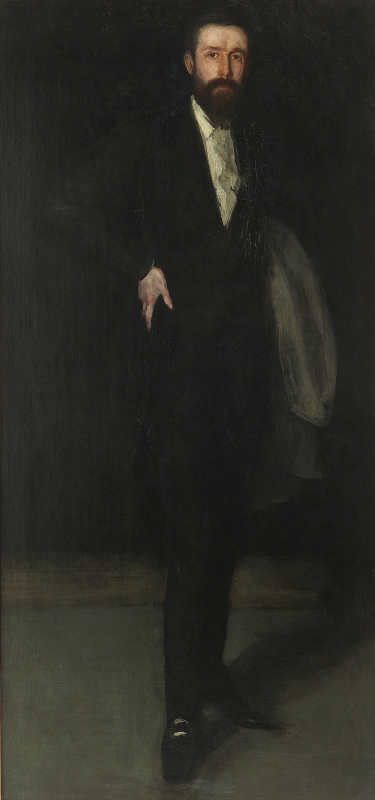Provenance
- 1870s: commissioned by Frederick Richards Leyland (1832-1892) although Whistler retained possession for many years;
- 1892: passed on the sitter's death to his daughter, Florence Leyland (1859-1921) , Mrs Val Prinsep;
- 1905, May: sold by Mrs Prinsep, and bought from William Marchant, London dealers, through Richard Albert Canfield (1855-1914), by Charles Lang Freer (1856-1919) , Detroit;
- 1919: bequeathed by C. L. Freer to the Freer Gallery of Art.
It was commissioned by the sitter and first mentioned as being painted at his residence, Speke Hall near Liverpool, in August 1870. 1 After his quarrel with Leyland, Whistler had no further sittings from Leyland, nor did he send Leyland the completed portrait. Whistler wrote to T. Watts-Dunton in February 1878 that he meant to deliver it but had not done so because Leyland did not seem to appreciate it. 2
According to Jacques Émile Blanche (1861-1942), he saw 'les Leyland', which he described as a series of arrangements 'en noir et brun', in Whistler's Tite Street studio about 1884. 3 However, it is actually unlikely that the portrait of Leyland was still there.
The portrait passed on the sitter's death to his daughter, Florence Leyland, Mrs Val Prinsep. In 1905, after the Whistler Memorial exhibition in London, it was bought by C. L. Freer from the gambler and collector, R. A. Canfield, through Marchant, for £3000.
Exhibitions
- 1874: Mr Whistler's Exhibition, Flemish Gallery, 48 Pall Mall, London, 1874 (cat. no. 1) as 'Portrait, "Arrangement in Black" '.
- 1905: Memorial Exhibition of the Works of the late James McNeill Whistler, First President of The International Society of Sculptors, Painters and Gravers, New Gallery, Regent Street, London, 1905 (cat no. 100) as 'Portrait of F. R. Leyland, Esq.'
In November 1872, Whistler's mother, Anna Matilda Whistler (1804-1881), wrote that he was hoping to complete the portrait for the Royal Academy the following year, but it was not eventually submitted. 4 According to Dante Gabriel Rossetti (1828-1882), Whistler 'must have finished the Leyland portraits, and persuaded L. that they were sure to be hung badly if sent to the R.A. - whereupon L., rather than see himself hoisted, paid bang out for an independent show of them.' 5
Reviewing the 1874 exhibition, the art critic of the Pall Mall Gazette described the portrait of Leyland as 'a most remarkable specimen of the art' and commended Whistler's work as 'an accomplishment of the strongest and most original kind.' 6
A review of this 'independent show' in The Hour, in 1874, inspired a letter from Whistler to the editor:
'I have read the intelligent remarks of your critic upon my pictures, and am happy to be able to remove, I think, the "melancholy" impression left upon his mind by the supposition that "the best works are not of recent date." Permit me to reassure him, for the paintings he speaks of in glowing terms - notably "the full-length portrait of a young girl," which he overwhelms me by comparing to Velasquez, as well as the two life-size portraits in black, "in which there is an almost entire negation of colour" (though I, who am, he says, a colourist, did not know it) - are my latest works, and but just completed. ...
… it was from no feeling that "my works were not seen to advantage when placed in juxtaposition with those of an essentially different kind," that I "determined to have an exhibition of my own, where [no] discordant elements should distract the spectator's attention." It is true that occasionally it has been borne in upon my mind that those whose "works are of an essentially different kind" are unwilling to place mine in juxtaposition with their own.
My wish has been, though, to prove that the place in which works of art are shown may be made as free from "discordant elements which distract the spectators' attention" as the works themselves.
Marvelling greatly that the "principle" that has led me (in his eyes at least) to paint so that he speaks of me in the same breath with Velasquez, should be "founded on fallacy," -
I remain, sir, your obedient servant, [butterfly] 7
By the terms of C. L. Freer's bequest to the Freer Gallery of Art, the painting cannot be lent to any other venue.
Notes:
1: A. M. Whistler to J. H. Gamble, 7 September 1870, GUW #06545.
2: 2 February [1878], draft, GUW #06073; as sent, GUW #09577.
3: Blanche 1905 [more] , at p. 358. He may have seen Portrait of Miss Florence Leyland [YMSM 107], Portrait of Miss Leyland (1) [YMSM 109], and/or Portrait of Miss Leyland (2) [YMSM 110].
4: A. M. Whistler to J. H. Gamble, 5 and 22 November 1872, GUW #06553.
5: Letters to Ford Madox Brown, n.d. (autumn), and 31 May 1874; quoted by Doughty and Wahl, op. cit. See Spencer 1987 [more] .
6: 'Exhibition of Mr. Whistler's Pictures', Pall Mall Gazette, London, 13 June 1874, p. 11.
7: 10 June 1874, GUW #11384. 'Mr Whistler's Pictures', The Hour, 11 June 1874, p. 7; reprinted in Whistler 1890 [more] , pp. 47-48, under the heading ' "Confidences" with an Editor.' This transcription is taken from the latter; there were minor variations in punctuation in the original, 'occasionally' read 'necessarily', and the letter was signed 'J. A. McN. WHISTLER / 48 Pall Mall, June 10'. See Getscher 1986 [more] , p. 27 (B. 4), p. 275 (L.1a). A copy of the review in The Hour was kept by Whistler, GUL Whistler pc1, p. 71.
Last updated: 23rd April 2021 by Margaret





